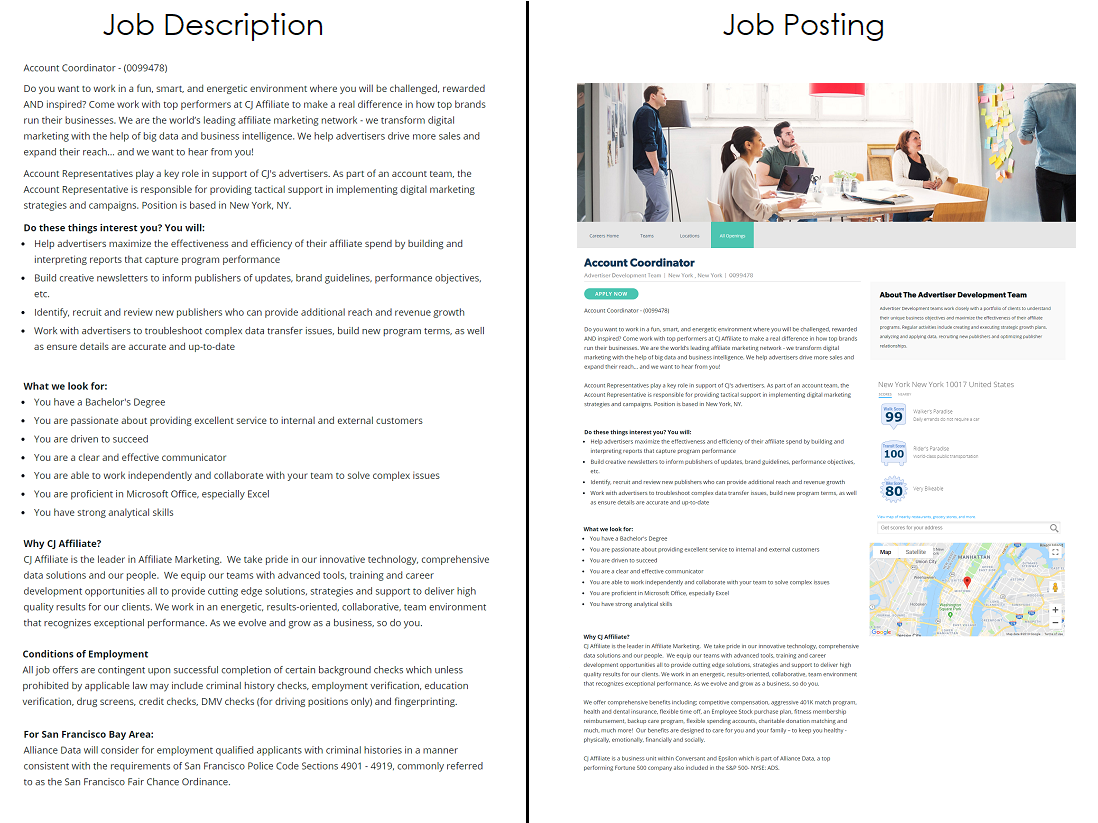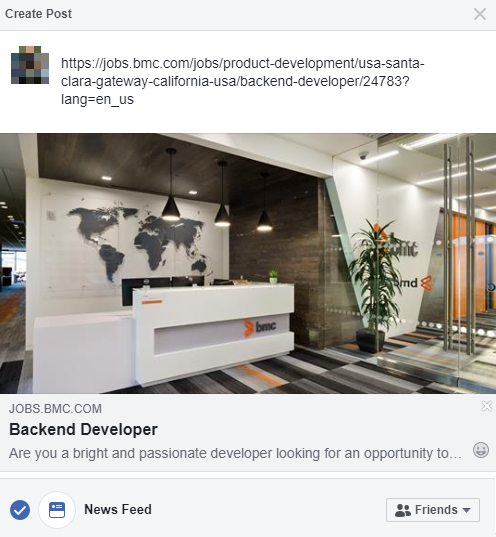- What’s the Difference Between a Job Description, Job Posting, and Job Ad - June 5, 2025
- Top 20+ Diversity Equity Inclusion Titles (with Descriptions) 2024 - October 18, 2024
- A List of Common Offensive (Exclusionary) Words Used in Job Descriptions (2024) - October 18, 2024
Even the most seasoned recruiters and HR professionals are still confused about the difference between a job description, a job posting, and a job ad. Although these terms are commonly used interchangeably, they have different meanings and serve various purposes.
In a recent episode of the JD Fix podcast, Heather Fenty discussed each format’s distinct roles, why HR and TA teams should stop treating them as synonyms, and how to use them strategically.
Here’s some clarity based on the many years my team and I have spent automating our job description software.
What is a Job Description?
A job description (JD) is the foundational, internal document that defines a role within an organization. It includes key details like:
- Primary responsibilities
- Required skills and qualifications
- Reporting structure
- Compensation or pay bands
- Work environment (e.g., hybrid, remote, on-site)
Note: Some of this article is excerpted from the recently written free Job Descriptions Guide by Ongig.
The reason that “job descriptions” is used as an umbrella term is that the JD is where it all begins. Typically, the job description writing process is a collaboration between hiring managers, recruiters, and the compensation team. It might look like this:
- A hiring manager describes the position they need filled (duties, skills and other requirements, etc.). It may also include success metrics. So, some call this the position description.
- A recruiter or other HR person works with the hiring manager to complete the job description (e.g. handling standard sections that the hiring manager doesn’t have to worry about (Benefits, EEO/Diversity Statement).
- The Compensation team nails salary/bonus info
- This job description becomes the “system of record” for the job that needs to be filled
Why It Matters:
Heather highlights that job descriptions aren’t just for hiring. They serve two functions:
- Internally, it aligns decision-makers on what the job entails.
- Externally, it should be the starting point for drafting your job posting. They shouldn’t be the final version.
They’re also vital for HR planning, compensation benchmarking, compliance, and performance management documents.
Copying and pasting this document into your job board isn’t just lazy—it’s ineffective. The JD often includes internal jargon, unnecessary legalese, or structural information that could confuse applicants.
The best job descriptions include text that is:
- Gender-neutral
- Readable
- Positive sentiment
- Simple, as opposed to complex words
And now on to the external-facing job posting…
What is a Job Posting vs a Job Description?
A job posting is the version of the job description meant for the outside world, specifically, potential candidates. It also has:
- Job Title and Summary: Clear and engaging overview.
- Company Overview: Culture, mission, and values.
- Application Process: Steps for candidates to apply.
It usually lives on your company career page, LinkedIn Jobs, Indeed, Glassdoor, or other job boards. Some employers copy most or all of the content from their internal job description, while others remove salary, reporting structure, or internal metrics.
A job posting allows you to communicate directly with candidates. As discussed in the podcast, it should answer candidates’ common concerns like:
- “What will I be doing?
- “Do I meet the requirements?
- “What’s in it for me?
- “Why should I apply here instead of somewhere else?”
The best job postings:
- Use straightforward language
- Use inclusive and engaging words and phrases
- Focus on must-have vs. nice-to-have skills
- Highlight flexibility, benefits, and career growth
- Avoid overwhelming candidates with long bulleted lists.
- Incorporate relevant keywords to optimize job posts on search engines.
According to Indeed, 52% of job seekers say the quality of a job description is very or extremely influential on their decision to apply for a job. CareerPlug’s Candidate Experience Report found that job posts that clearly outline pay and benefits attract more applicants and build trust.
An Example of a Job Description vs Job Posting

What is a Job Ad?
A job ad is where recruitment meets marketing.
Heather defines a job ad as a strategic marketing asset that boosts visibility and traffic to your job posting. It often includes:
- Paid job board promotions (e.g., sponsored listings)
- Social media content (LinkedIn, Facebook, TikTok)
- Email campaigns or digital banners
Unlike a job posting, which gives the complete picture, a job ad is designed to quickly grab the attention of job seekers, like a billboard that says: “This opportunity is worth clicking.”
The key components of a job ad include:
- An eye-catching headline (e.g., “Work from anywhere. Great pay. No micromanagement.”)
- A short description of the role or company value proposition
- Visual content, like a team photo or video testimonial of an employee
- A clear call to action (CTA): “Apply now” or “See what it’s like to work here”
Others use the term “job ad” to describe a job page with extra engagement. Katrina Kibben of Three Ears Media, for example, defined a job ad (in 7 Things I Learned Writing Job Postings in 60 Days) as:
“What you use on Facebook or social media, for example, that promote the job. These are strategic images, sponsored posts, etc.”
I see where Katrina is coming from.
The “ad” in “job ad” suggests the job page is paid for one way or the other (the employer either paid a job board or invested in strategic images or video or leveraging copywriters, etc.).
So, the best job ads are:
- Optimized for social sharing (LinkedIn, Facebook, Twitter)
- Have an engaging thumbnail image
- A snippet of the job description (focused on company or position)
- Link to the job posting

According to Wordstream’s Google Ads Benchmarks report, the average metrics for the “Career & Employment” industry are:
- Average Click-Through Rate (CTR): 6.79%. CTR is the percentage of applicants who click on a job ad after seeing it
- Average Conversion Rate (CVR): 5.63%. It measures the percentage of candidates who completed the application.
These figures indicate that the “Career & Employment” sector performs slightly above the overall averages across all industries:
- Overall Average CTR: 6.42%
- Overall Average CVR: 6.96%
Differences Between A Job Description, A Job Posting, And A Job Ad
I’ve compiled the differences between a job description, a job posting, and a job ad in a table format to make for easy understanding.
| Aspect | Job Description | Job Posting | Job Ad |
| Definition | Detailed document outlining job responsibilities, requirements, and qualifications. | Online announcement of an open position, usually posted on job boards or company websites. | Marketing content aimed at attracting potential candidates to apply for the job. |
| Purpose | Provide a comprehensive understanding of the role for both hiring managers and candidates. | Inform potential candidates about job openings and encourage them to apply. | Capture the attention of potential candidates and persuade them to apply. |
| Key Components |
|
|
|
| Audience | Internal and external candidates, HR team, and hiring managers. | External candidates actively seeking job opportunities. | Passive and active job seekers, often used to attract a wider audience. |
| Length | Detailed and often lengthy, providing extensive information. | Concise but informative, typically shorter than a job description. | Brief, engaging, and to the point, designed to capture interest quickly. |
| Tone | Formal and informative, focused on clarity and detail. | Professional and clear, aimed at providing essential information. | Engaging, persuasive, and appealing, with a marketing focus. |
| Usage | Used internally for HR and hiring managers to ensure clarity about the role; shared with candidates during later stages of recruitment. | Posted on job boards, company websites, and other platforms to notify potential candidates of the opening. | Distributed through various channels including social media, websites, and sometimes print media to attract candidates. |
Why It Matters to Get This Right
Confusing or blending these tools can confuse candidates and create inefficiencies for recruiters.
✅ Better Candidate Experience
Candidates today expect clarity. If your job ad links to an outdated job description, you risk losing them. According to CareerPlug, poor experiences, such as unclear job expectations, led 26% of job seekers to decline offers. In comparison, 66% of candidates said a positive experience influenced their decision to accept a job offer.
✅ Improved Employer Brand
Every piece of your hiring content represents your company. Sharp, distinct formats show professionalism and respect for candidates’ time.
✅ Faster, Smarter Hiring
When each document has a clear purpose and audience, it’s easier to attract, screen, and hire qualified talent without wasting resources.
Role of AI in creating inclusive job descriptions, job postings, and job ads
We can’t talk about creating job descriptions or postings without considering how AI helps streamline our efforts.
Many statistics show that AI, especially generative AI, is becoming more popular in HR. 81% of HR professionals have tried or used AI to improve their processes. Another study shows that 66% of CEOs think their HR departments will benefit from using Artificial Intelligence in their workflows.
I work with HR and DEI leaders and see how they use AI to make their job posting process smoother.
Bias Detection and Correction
The most popular role I’ve seen AI play in the creation of job descriptions is bias detection and correction.
More companies are realizing that inclusive language in job ads matters. And why not? A study by ZipRecruiter also shows that removing gender-coded language from job ads leads to more responses.
In the past, you had to manually review job ads and hope you didn’t miss anything to avoid discrimination. But now, with AI tools like Ongig, it’s easier than ever to write and analyze job descriptions for biased language that might deter some people from applying to open roles in your organization.
Watch this video to see how Ongig’s Text Analyzer can help you create effective and inclusive job descriptions.
Consistency and Standardization
Another way I see organizations use AI in their job descriptions is to ensure consistency across multiple job descriptions.
When you have hundreds of job descriptions, you can find that some are too long, have inconsistent sections, or are stored in multiple places in different formats. Candidates expect clear and professional communication, and a lack of standardization can push them away.
Ongig’s customers solve this problem with our centralized job description automation system. This system helps organizations quickly get large-scale job ads out while staying consistent, compliant, and inclusive.
For example, Supplement Healthcare (SHC) uses Ongig’s platform for 100% of its job postings, even when posting over 100,000 jobs per month. Read about how they streamlined their job posting process here.
For some tips on writing job descriptions (or job postings), check out How to Write a Job Description — Best Practices & Examples.
Why I Wrote This
As the JD Fix podcast reminds us, your job descriptions, postings, and ads each play a unique and critical role in your hiring funnel. Treating them as interchangeable isn’t just inaccurate. It also costs you talent.
So, if you want to attract top talent and remove bias from your job descriptions, check out Ongig’s Candidate Experience and Text Analyzer software.
Shout Outs:
The JD Breakdown: Job Description vs. Job Posting vs. Job Ad – Substack
How to Write a Job Description – Indeed
2025 Candidate Experience Report – CareerPlug
Google Ads Benchmarks 2024: New Trends & Insights for Key Industries – Wordstream
66% of CEOs think Generative AI can drive significant value in Human Resources – Fluid AIThings I Learned Writing Job Postings in 60 Days – Three Ears Media
